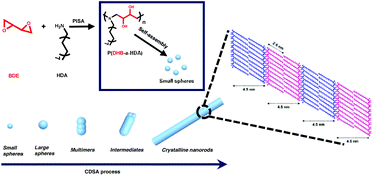当前位置:
X-MOL 学术
›
Polym. Chem.
›
论文详情
Our official English website, www.x-mol.net, welcomes your feedback! (Note: you will need to create a separate account there.)
Scalable preparation of crystalline nanorods through sequential polymerization-induced and crystallization-driven self-assembly of alternating copolymers
Polymer Chemistry ( IF 4.6 ) Pub Date : 2020/03/03 , DOI: 10.1039/d0py00093k Rui Yin 1, 2, 3, 4, 5 , Dipankar Sahoo 1, 2, 3, 4, 5 , Fugui Xu 1, 2, 3, 4, 5 , Wei Huang 1, 2, 3, 4, 5 , Yongfeng Zhou 1, 2, 3, 4, 5
Polymer Chemistry ( IF 4.6 ) Pub Date : 2020/03/03 , DOI: 10.1039/d0py00093k Rui Yin 1, 2, 3, 4, 5 , Dipankar Sahoo 1, 2, 3, 4, 5 , Fugui Xu 1, 2, 3, 4, 5 , Wei Huang 1, 2, 3, 4, 5 , Yongfeng Zhou 1, 2, 3, 4, 5
Affiliation

|
We report a sequential polymerization-induced self-assembly (PISA) and crystallization-driven self-assembly (CDSA) method (sequential PI/CDSA) to prepare crystalline nanorods on a large scale. The self-assembly was initiated by the click copolymerization between an epoxy and amine monomer pair to obtain alternating copolymers, and performed in one pot but with two steps. In the first step, the PISA of these two monomers generated small spheres; in the second step, the small spheres turned into nanorods through a CDSA process. The obtained nanorods are 200 nm in diameter and several microns in length, and have an ultrathin lamellar structure. This work will broaden the toolbox for polymer self-assembly for the scalable preparation of non-spherical supramolecular materials.
中文翻译:

通过交替聚合的顺序聚合诱导和结晶驱动的自组装可扩展地制备晶体纳米棒
我们报告了顺序聚合诱导自组装(PISA)和结晶驱动自组装(CDSA)方法(顺序PI / CDSA),以大规模制备晶体纳米棒。通过在环氧和胺单体对之间进行点击共聚以得到交替共聚物来引发自组装,并在一个罐中但以两个步骤进行。第一步,这两种单体的PISA产生了小球;在第二步中,小球通过CDSA工艺变成纳米棒。所获得的纳米棒的直径为200nm,长度为几微米,并且具有超薄的层状结构。这项工作将拓宽聚合物自组装的工具箱,以可扩展地制备非球形超分子材料。
更新日期:2020-03-31
中文翻译:

通过交替聚合的顺序聚合诱导和结晶驱动的自组装可扩展地制备晶体纳米棒
我们报告了顺序聚合诱导自组装(PISA)和结晶驱动自组装(CDSA)方法(顺序PI / CDSA),以大规模制备晶体纳米棒。通过在环氧和胺单体对之间进行点击共聚以得到交替共聚物来引发自组装,并在一个罐中但以两个步骤进行。第一步,这两种单体的PISA产生了小球;在第二步中,小球通过CDSA工艺变成纳米棒。所获得的纳米棒的直径为200nm,长度为几微米,并且具有超薄的层状结构。这项工作将拓宽聚合物自组装的工具箱,以可扩展地制备非球形超分子材料。



























 京公网安备 11010802027423号
京公网安备 11010802027423号